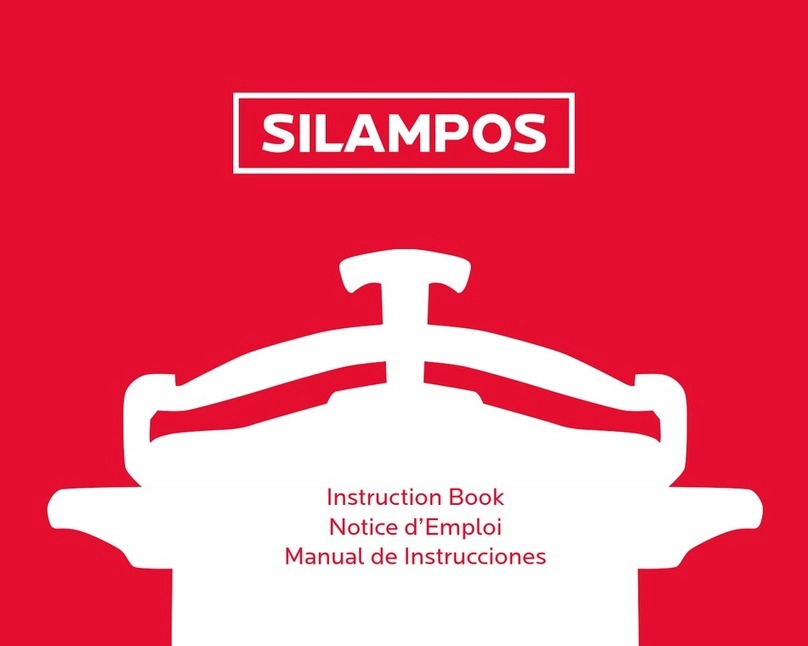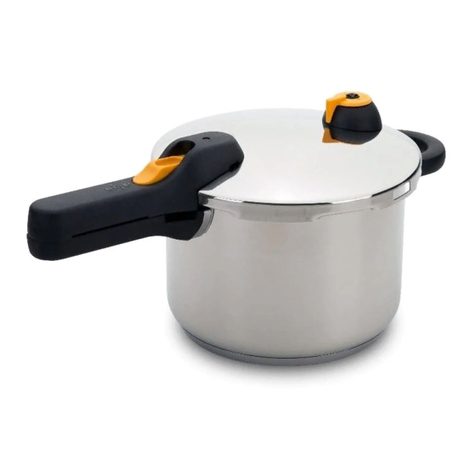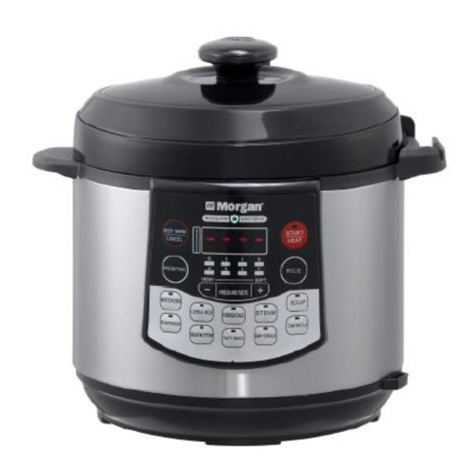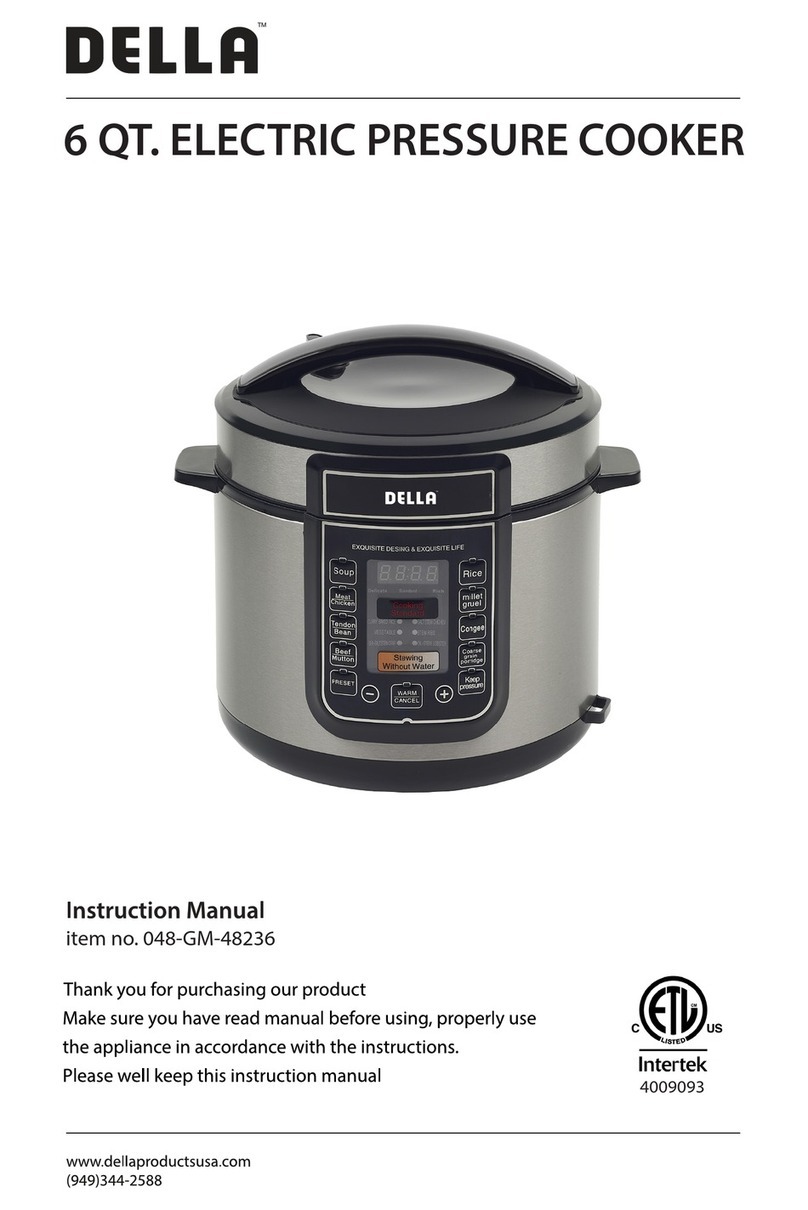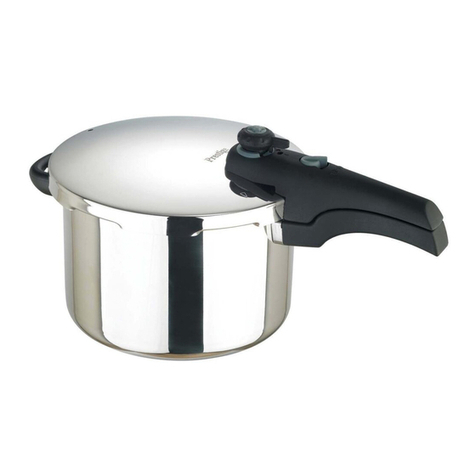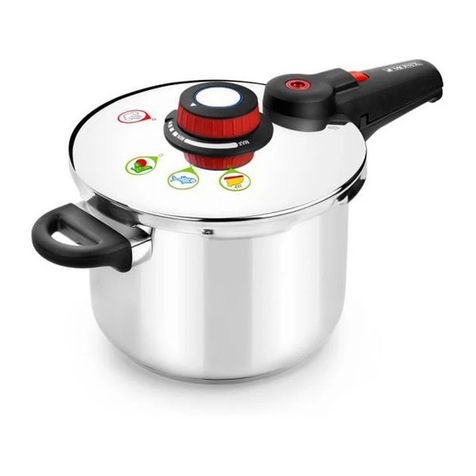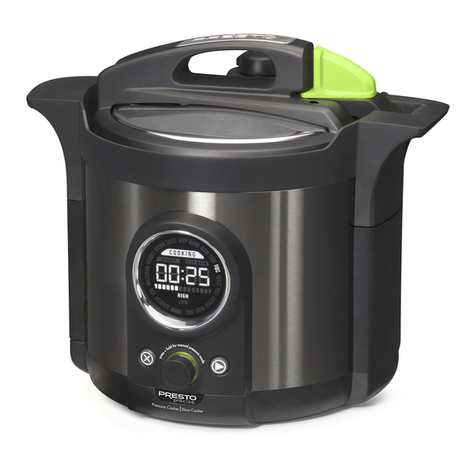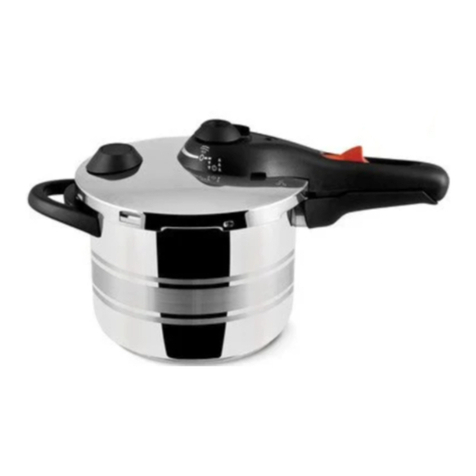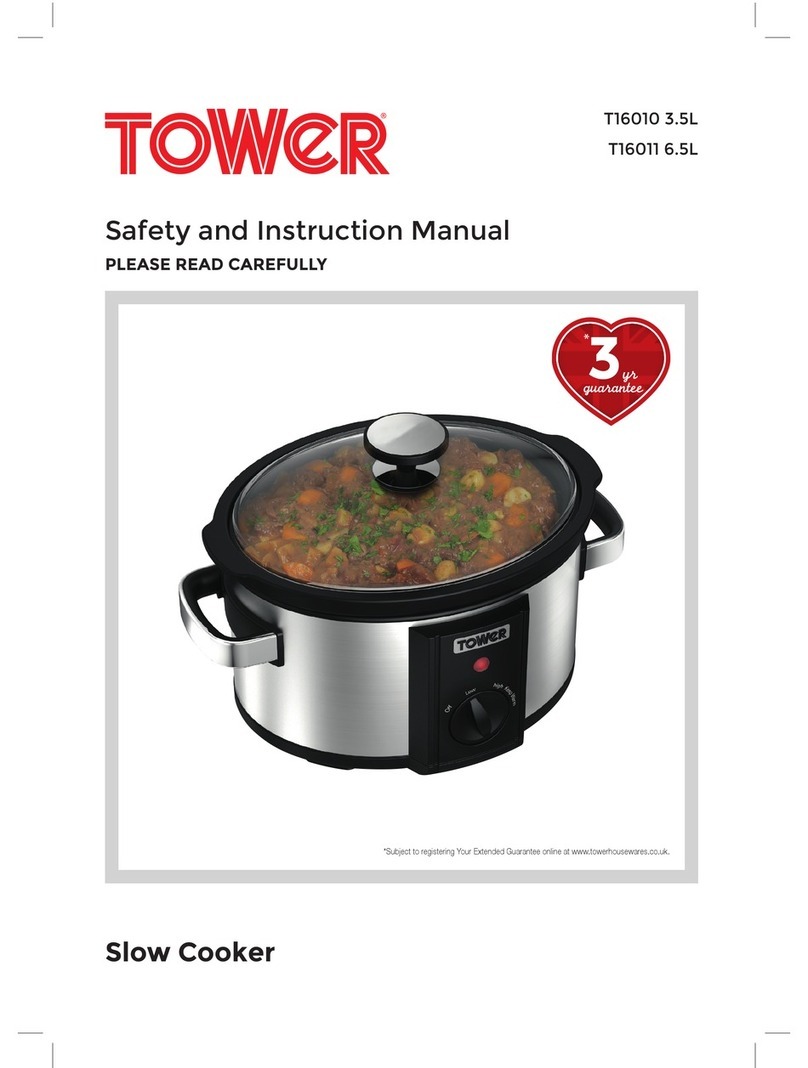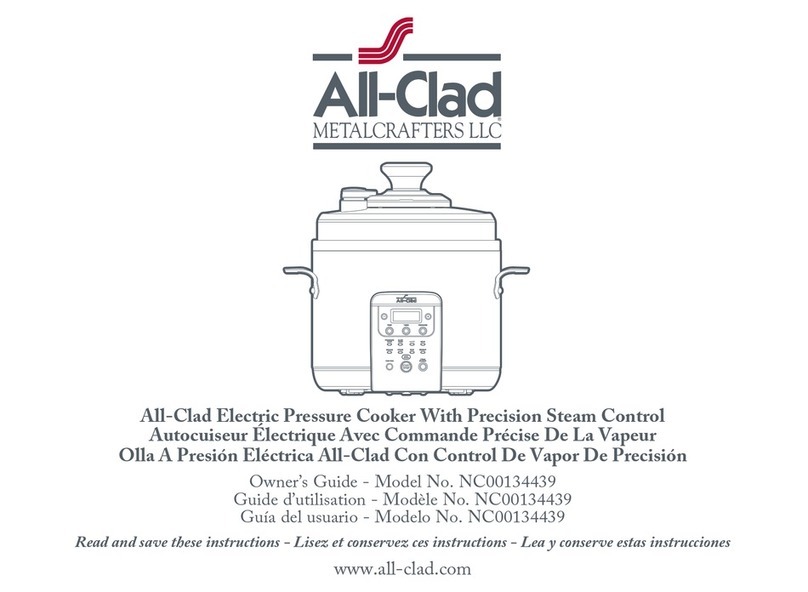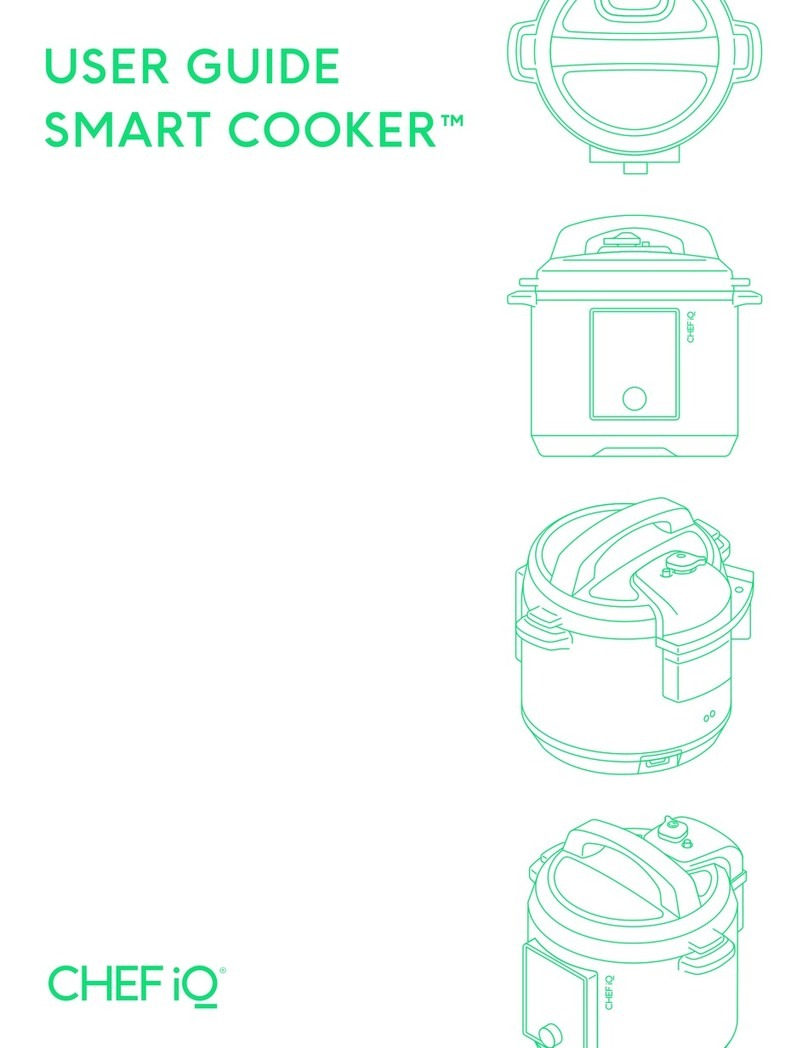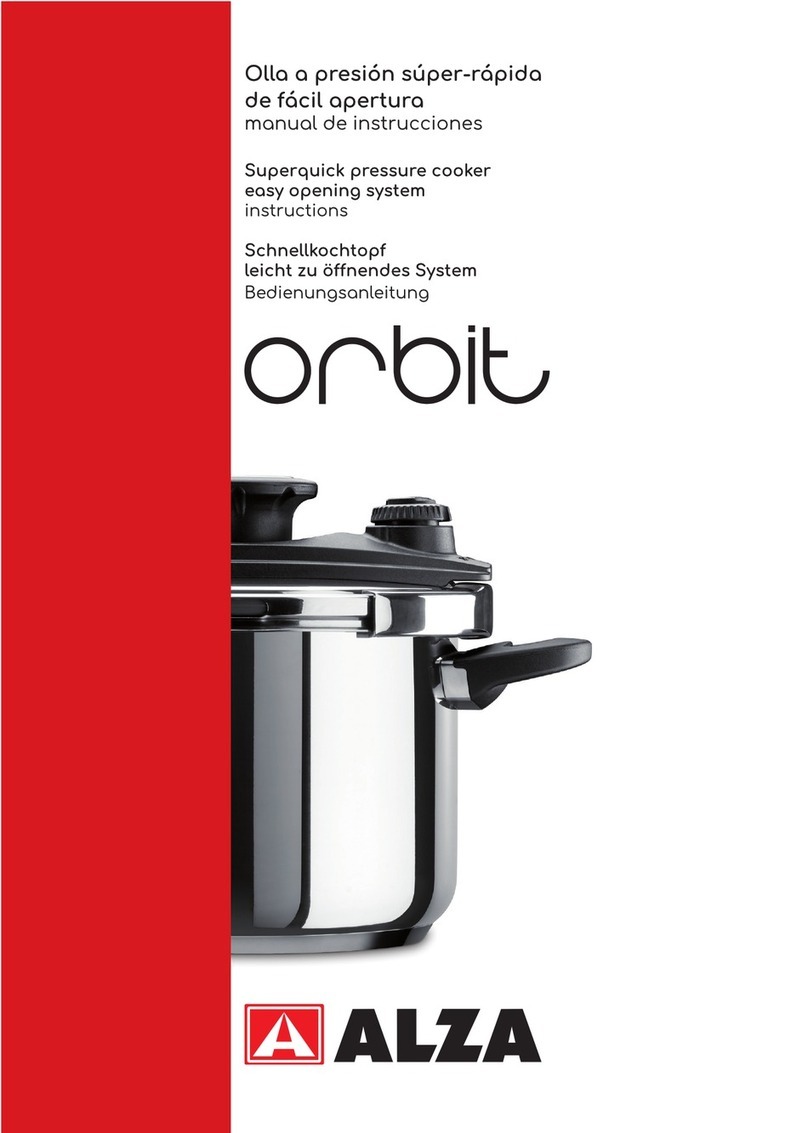Silampos Easy User manual


TABLE OF CONTENTS
0. IMPORTANT PRECAUTIONS
1. PRODUCT DESCRIPTION PAG02
2. PRIOR TO FIRST USE PAG04
3. USING THE PRESSURE COOKER PAG05
4. UPKEEP AND MAINTENANCE PAG10
5. WARRANTY CERTIFICATE PAG14
6. DECLARATION OF COMPLIANCE PAG14
7. COOKING TIMES PAG15
Pressure Cooker
Easy
Recommended maximum power 3000W
IMPORTANT PRECAUTIONS
1. Read the present instructions carefully to the end so as to become familiar with the characteristics and potential
of the pressure cooker.
2. Take great care when using it near children.
3. Do not place the pressure cooker in a heated oven.
4. When the pressure cooker is under pressure, handle it very carefully. Do not touch warm surfaces. Use the
handles and, if necessary, use gloves or another mean of protection.
5. Do not use the pressure cooker for any purpose other than that for which it is intended.
Recommended heat sources

6. The pressure cooker works under pressure. Misuse may cause burns and serious damages. Check that the
pressure cooker has been properly closed and the valves are clear before placing it on the heat source. Read the
chapter “Using the pressure cooker”.
7. Never force the opening of the pressure cooker or remove the lid without rst checking that the pressure cooker
is depressurised. See the instructions on depressurisation in point 3.3 of the present manual.
8. Do not use the pressure cooker without liquid inside, as it could be seriously damaged. Read the chapter “Prior
to First Use”.
9. Do not ll the pressure cooker more than 2/3 of its capacity. With food which increases in volume during cook-
ing, such as rice or dry vegetables, do not ll the pressure cooker more than half of its capacity.
10. Do not place an empty pressure cooker on a connected source of heat.
11. When you use an electrical or vitroceramic griddle, use a disk with a diameter which is equal to or lower than
the diameter of the bottom (Bd) of the pressure cooker. Make sure the bottom of the cooker is clean and dry.
12. When you use a gas stove, adjust the ame so it doesn’t go above the diameter of the bottom.
13. The supercial skin of some meats swells under the effect of pressure (e.g. tongue). After cooking, do not prick
the meat if it looks swollen; you may scald yourself. Prick the meat before cooking.
14. When making greasy foods, you should shake the pressure cooker slightly before opening the lid, preventing
the food from spitting out.
15. Do not use the pressure cooker under pressure for frying food.
16. Do not operate the safety systems more than that which is recommended in the cleaning and maintenance
instructions. Read the chapter “Upkeep and maintenance”.
17. Do not use the pressure cooker when it, or any of its components, is damaged or does not correspond to the
functions described in the usage instructions. Only use replacement parts of the Silampos brand and of the model
in question. Contact the Silampos Post Sales Assistance Service.
18. FOLLOW AND KEEP THESE INSTRUCTIONS
IMPORTANT PRECAUTIONS PAG01

PAG02 PRODUCT DESCRIPTION
* Pressure unit: 1 bar = 1kg/1cm2 (a force of 1kg is exercised over an area of 1cm2)

PRODUCT DESCRIPTION PAG03
Only use replacement parts of the SILAMPOS brand and of the model in question.
Contact the Silampos Post Sales Assistance Service.

PAG04 PRIOR TO FIRST USE
Prior to rst use, remove all the labels from the pressure cooker. Wash it in hot water and washing-up
liquid. After washing, dry it with a cloth.
Lubricate the sealing ring with a bit of cooking oil to facilitate the opening and closing of the pressure
cooker. Make sure the steam release devices are clear.
Give the pressure cooker a test run using half a litre of water. Let it cook for 10 minutes until the
adjustment valve starts giving off steam.
Minimum Quantity:
You should not use the pressure cooker with a quantity of liquid of under 250 ml; you may damage
the pressure cooker and/or the heat source.
Maximum Quantity:
Do not ll the pressure cooker more than 2/3 of its capacity.
Please note
if you exceed the limit of the capacity, the steam could be released through the adjust-
ment valve or through the edge of the lid. This could also occur if the heat source is too high.

USING THE PRESSURE COOKER PAG05
3.1 PRIOR TO USE
1. Place the ring on the inner edge of the lid, checking that it is adjusted and correctly placed in ac-
cordance with (FIG.01)
2. Check whether the adjustment valve is clear: Pull the selector button, turn it to the position ,
remove it and check whether the channel is clear. (FIG.02)
3. Check whether the safety valve is clear, lightly pressuring the valve piston via the interior of the
lid, with the aid of a pointed object. (FIG.03)
4. To close the pressure cooker, place the lid in such a way as to make the lid close position indicator
coincide with the close position indicator of the pressure cooker handle and turn the lid
clockwise. (FIG.04)
5. After ensuring the overlaying of the lid handles and of the pressure cooker unit (FIG.05), pull the
button to the close position until you hear a click. (FIG.06)

PAG06 USING THE PRESSURE COOKER
(FIG.01) (FIG.02) (FIG.03)
(FIG.04)(FIG.05) (FIG.06)

USING THE PRESSURE COOKER PAG07
3.2 DURING USE
1. Place the pressure cooker on the connected heat source.
Please note
that with induction-heating cooking, extremely high temperatures are reached in a
matter of seconds, which requires greater precaution and care.
2. Select the pressure level you wish to use:
- Position (0.5 bar): for fast cooking;
- Position (0.9 bar): for super fast cooking.
3. Start counting cooking time after checking that the steam is coming out in constant fashion via
the adjustment valve.
4. If during the use of the pressure cooker the pressure indicator fails to rise and/or the adjustment
valve does not release steam, check whether the power of the heat source is strong enough. Should
this persist, depressurise the pressure cooker and check:
- Whether the quantity of liquid inside the pressure cooker is sufcient;
- Whether the pressure cooker is closed;
- Whether the adjustment valve is clear;
- Whether the silicone sealing ring and the edge of the lid are in good conditions.
During the rst minutes of the cooking process, it is normal if the adjustment valve does not release
the steam or do it intermittently.
5. Do not place objects on the pressure indicator and/or adjustment valve whilst the pressure cooker
is working.

PAG08 USING THE PRESSURE COOKER
6. Use the heat stored in the thermal bottom and save energy by disconnecting the heat source
before the food cooking time has terminated.
7. If steam is released via the lid edges, via the safety valve and/or via the expansion window, re-
move the pressure cooker from the heat source, depressurise it and check:
- Whether the adjustment valve is clear;
- Whether the sealing ring is clean, properly positioned and shows any sign of deterioration;
- Whether the edge of the pressure cooker unit shows any signs of deterioration which prevent the
effective adjustment of the sealing ring.
3.3 UPON COMPLETION OF USE
1. Once the cooking time has elapsed, remove the pressure cooker from the heat source and de-
pressurise it, slowly turning the selector button to the position indicated in (FIG.07), to release the
steam.
Please note
that you should be extremely careful to avoid any burns which may be caused
by the steam released.
2. After depressurisation, open the pressure cooker moving the button from the close to the open
position until you hear a click (FIG.08); remove the lid, turning the handle anti-clockwise. (FIG.09).
Please note
that you should not force the opening of the pressure cooker until the pressure indicator
is totally down, as this practice can put the user in danger and damage the cooker.
3. To handle the pressure cooker only use Bakelite accessories and, where necessary, wear gloves or
some other means of protection. (FIG.10).

USING THE PRESSURE COOKER PAG09
4. Wash the pressure cooker in plentiful water and washing-up liquid to prevent the stainless steel
from being eroded by the cooking of salty or acidic foods. You can wash the pressure cooker in the
dishwasher, removing the sealing ring rst.
5. If you burned the food during the cooking process: Leave the pressure cooker to rest in water and
some washing-up liquid for a few minutes before washing it.
6. For more thorough cleaning:
- Remove the sealing ring and wash it.
- Remove the selector button and rinse under the tap via the adjustment valve (FIG.11).
Reset the selector button and check whether the system has been properly assembled. This shall be
easy to move.
Please note
that an improper assembly may make the operation of the adjustment
valve difcult or even stop it from working, obliging the safety valve to operate.
- Check whether the safety valve is clear, lightly pressing the valve piston via the interior of the lid
with the aid of a pointed object.
7. Once clean and dry, put the pressure cooker away without its lid on to avoid deformations to the
sealing ring. (FIG.12)
(FIG.07) (FIG.08) (FIG.09)

PAG10 USING THE PRESSURE COOKER
(FIG.10)(FIG.11)
Keep your pressure cooker in good working order for longer:
- Don’t heat the pressure cooker when it’s empty. If you left the pressure cooker on the heat source
without any liquid inside, take the pressure cooker to the Silampos post-sales assistance service to
be checked.
- The salty cooking water and the water with washing-up liquid shall not remain in the pressure
cooker for long time periods.
- After 10 years it is recommended you carry out a general revision of the pressure cooker at the
Silampos post-sales assistance service.
UPKEEP AND MAINTENANCE
(FIG.12)

UPKEEP AND MAINTENANCE PAG11
- Replace the sealing ring every year or at least every two years.
It will need to be replaced early whenever the following occur:
- Cracks or dents
- Deformations;
- Dark appearance;
- Lack of exibility.
Any of the aforementioned irregularities may prevent the correct sealing or closure of the pressure
cooker.
To place a new sealing ring:
- Select a Silampos sealing ring identied
in the table (pag.03)
- Place the ring on the inner edge of the lid, checking
that it is adjusted and properly placed.

PAG12 UPKEEP AND MAINTENANCE
OCCURRENCE
Removal of labels
Use of abrasive pads
Use of detergents
Burned food
Limescale stains (whitish stains)
RECOMMENDATION
Wetten the label in very hot water and remove
it. If traces of glue remain, soak a bit of cotton
wool in alcohol and wipe.
This type of wire mesh scratches the surface of
the pressure cooker. Rub horizontally and not
vertically.
Do not use disinfectants containing bleach or
other detergents containing chlorine (Cl).
Add some water and ammoniac detergent and
leave to rest for a few minutes. Wash the piece
normally.
Add a bit of vinegar and water and heat the
pressure cooker for a few minutes. Leave to
cool and wash normally.

OCCURRENCE
Rust stains (brownish stains)
Food stains
Excess heat stains (coloured stains)
RECOMMENDATION
Do not use steel wire pads when cleaning stain-
less steel parts. This type of pad may leave rust
stains, permanently damaging the surface of
the piece. Use stainless steel pads.
Add some bicarbonate of soda and water and
heat the piece for a few minutes. Leave to cool
and wash.
Clean the piece with a 10% nitric acid diluted
solution, or use brighteners for chrome items.
The SILAMPOS cleaning product is recommended and effective at removing stains and residues,
making your pressure cooker shine again.
UPKEEP AND MAINTENANCE PAG13

PAG14 WARRANTY CERTIFICATE
The Silampos Easy pressure cooker has a 2-year warranty and a specic 25-year warranty for its Impact Disc Plus
thermal bottom, against manufacturing defects. The consumer should inform the seller if there is any lack of com-
pliance within 2 months starting from the day it was detected in order to benet from the warranty. The warranty
period starts from the date of the product delivery and does not cover the parts subject to periodic replacement, as
classied in the instructions attached, and any damage caused by negligent use, improper use or accident. When
the product does not comply with the contract, the consumer has the right to require it for free. The warranty
shall be null and void when unauthorised entities have repaired, modied or replaced pressure cooker parts. The
expression “for free”, used previously, is related to the needed expenditures to establish the compliance of the
product with the contract, including namely transport, working force and material expenditures. Those expendi-
tures and the risks related to the postage of the pressure cooker to Silampos Customer Services and its subsequent
devolution to the client are Silampos responsibility only when the warranty duty is fullled. Any expenses relating
to the maintenance or restoration of the product apart from the appliance of the warranty shall be borne by the
consumer. The warranty is free and occurs automatically when purchasing the Easy pressure cooker. The rights
and duties of both involved parts are stipulated in the decree-law nº 67/2003, modied by the decree-law nº
84/2008, to which it is related to.
CONTACT FOR ASSISTANCES - Silampos, Sociedade Industrial de Louça Metálica Campos, S.A.
Rua das Cortinhas, nº.301 | 3701-906 Cesar PORTUGAL | Tel.: 351.256850400 | servicoaoconsumidor@silampos.pt
To all intents and purposes, we do hereby declare that the pressure cookers manufactured by Silampos comply
with the provisions of EEC Directive no.97/23 and the applicable standards, to wit EN 12778. As well as with EEC
Regulation no.1935/2004, ensuring that all the food compatibility requirements have been complied with.
Manufacturer SILAMPOS - Sociedade Ind. de Louça Metálica Campos, S.A. - P.O. Box 2004 - Cesar PORTUGAL
Evaluation of Compliance Module B “Exam CE de Tipo”
Body Notied CATIM - Centro de Apoio Tecnológico à Indústria Metalomecânica nº.0464
April 2008 Signature Engº. Anibal Campos
DECLARATION OF COMPLIANCE

COOKING TIMES PAG15
Cereals
Pearl barley (3 cups)
Basmati Rice (1 cup and a half)
Brown Rice (1 cup and a half)
Long grain rice (1 cup and a half)
Wheat grain (3 cups)
15/20 min
5/7 min
15/20 min
5/7 min
18 min
2nd Level
2nd Level
2nd Level
2nd Level
2nd Level
Approx. cooking time Pressure level
Meat
Beef/ veal
Kid/lamb
Whole chicken
Soup (meat)
35/40 min
10/18 min
12/18 min
10/15 min
2nd Level
2nd Level
2nd Level
2nd Level
Maximum cooking time Pressure level
Seafood and sh
Crab
Hake llets
Soup (sh)
Fish
Lobster
Mussels
Shrimp
2/3 min
2/3 min
5/6 min
5/6 min
2/3 min
2/3 min
1/2 min
1st Level
1st Level
2nd Level
1st Level
1st Level
1st Level
1st Level
Maximum cooking time Pressure level
THE COOKING TIMES CAN VARY DEPENDING ON THE HEAT SOURCE USED.



INDEX
0. PRÉCAUTIONS IMPORTANTES
1. DESCRIPTION DU PRODUIT PAG20
2. AVANT LA PREMIÈRE UTILISATION PAG22
3. UTILISER LA COCOTTE MINUTE PAG23
4. CONSERVATION ET ENTRETIEN PAG28
5. CERTIFICAT DE GARANTIE PAG32
6. DÉCLARATION DE CONFORMITÉ PAG32
7. TEMPS DE CUISSON PAG33
Cocotte minute
Easy
Puissance maximum recommandée de 3000W
PRÉCAUTIONS IMPORTANTES
1. Lire attentivement les présentes instructions jusqu’au bout, pour vous familiarisez avec les caractéristiques et
les potentialités de la cocotte minute.
2. Maintenez une vigilance rigoureuse quand vous utilisez la cocotte à proximité d’enfants.
3. Ne pas mettre la cocotte dans un four chauffé.
4. Quand la cocotte est sous pression, déplacez-la avec beaucoup de prudence. Ne touchez pas les surfaces
chaudes. Utilisez les anses, et si nécessaire, des gants de cuisine ou un autre moyen de protection.
5. Ne pas utiliser la cocotte minute à d’autres ns sinon celles auxquelles elle est destinée.
Sources d’énergie recommandées
Other manuals for Easy
1
Table of contents
Languages:
Other Silampos Electric Pressure Cooker manuals


